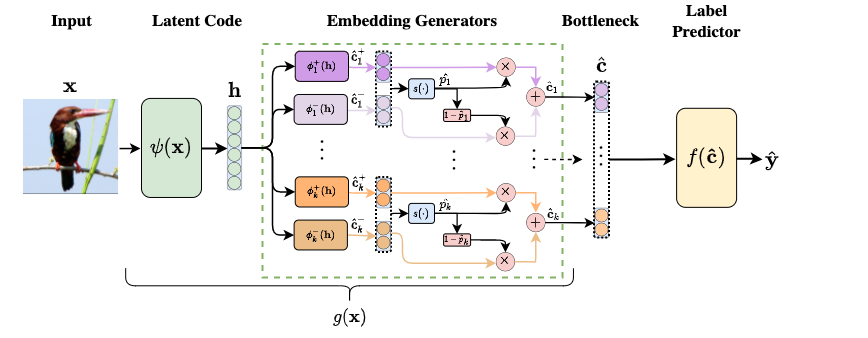This repository contains the official Pytorch implementation of our work "Concept Embedding Models" accepted at NeurIPS 2022. For details on our model and motivation, please refer to our official paper.
Concept Bottleneck Models (CBMs) have recently gained attention as high-performing and interpretable neural architectures that can explain their predictions using a set of human-understandable high-level concepts. Nevertheless, the need for a strict activation bottleneck as part of the architecture, as well as the fact that one requires the set of concept annotations used during training to be fully descriptive of the downstream task of interest, are constraints that force CBMs to trade downstream performance for interpretability purposes. This severely limits their applicability in real-world applications, where data rarely comes with concept annotations that are fully descriptive of any task of interest.
In our work, we propose Concept Embedding Models (CEMs) to tackle these two big challenges. Our neural architecture expands a CBM's bottleneck and allows the information related to unseen concepts to be flow as part of the model's bottleneck. We achieve this by learning a high-dimensional representation (i.e., a concept embedding) for each concept provided during training. Naively extending the bottleneck, however, may directly impede the use of test-time concept interventions where one can correct a mispredicted concept in order to improve the end model's downstream performance. This is a crucial element motivating the creation of traditional CBMs and therefore is a highly desirable feature. Therefore, in order to use concept embeddings in the bottleneck while still permitting effective test-time interventions, CEM construct each concept's representation as a linear combination of two concept embeddings, where each embedding has fixed semantics. Specifically, we learn an embedding to represent the "active" space of a concept and one to represent the "inactive" state of a concept, allowing us to selecting between these two produced embeddings at test-time to then intervene in a concept and improve downstream performance. Our entire architecture is visualized in the figure above and formally described in our paper.
In this repository, we include a standalone Pytorch implementation of CEM
which can be easily trained from scratch given a set of samples annotated with
a downstream task and a set of binary concepts. In order to use our implementation,
however, you first need to install all our code's requirements (listed in
requirements.txt). We provide an automatic mechanism for this installation using
Python's setup process with our standalone setup.py. To install our package,
therefore, you only need to run:
$ python setup.py installAfter this command has terminated successfully, you should be able to import
cem as a package and use it to train a CEM object as follows:
import pytorch_lightning as pl
from cem.models.cem import ConceptEmbeddingModel
#####
# Define your dataset
#####
train_dl = ...
val_dl = ...
#####
# Construct the model
#####
cem_model = ConceptEmbeddingModel(
n_concepts=n_concepts, # Number of training-time concepts
n_tasks=n_tasks, # Number of output labels
emb_size=16,
concept_loss_weight=0.1,
learning_rate=1e-3,
optimizer="adam",
c_extractor_arch=latent_code_generator_model, # Replace this appropriately
training_intervention_prob=0.25, # RandInt probability
)
#####
# Train it
#####
trainer = pl.Trainer(
gpus=1,
max_epochs=100,
check_val_every_n_epoch=5,
)
# train_dl and val_dl are datasets previously built...
trainer.fit(cem_model, train_dl, val_dl)To reproduce the experiments discussed in our paper, please use the scripts
in the experiments directory after installing the cem package as indicated
above. For example, to run our experiments on the DOT dataset (see our paper),
you can execute the following command:
$ python experiments/synthetic_datasets_experiments.py dot -o dot_results/This should generate a summary of all the results after execution has
terminated and dump all results/trained models/logs into the given
output directory (dot_results/ in this case).
If you would like to cite this repository, or the accompanying paper, please use the following citation:
@misc{https://doi.org/10.48550/arxiv.2209.09056,
doi = {10.48550/ARXIV.2209.09056},
url = {https://arxiv.org/abs/2209.09056},
author = {
Espinosa Zarlenga, Mateo and
Barbiero, Pietro and
Ciravegna, Gabriele and
Marra, Giuseppe and
Giannini, Francesco and
Diligenti, Michelangelo and
Shams, Zohreh and
Precioso, Frederic and
Melacci, Stefano and
Weller, Adrian and
Lio, Pietro and
Jamnik, Mateja
},
keywords = {
Machine Learning (cs.LG),
Artificial Intelligence (cs.AI),
FOS: Computer and information sciences,
FOS: Computer and information sciences,
I.2.6,
68T07
},
title = {Concept Embedding Models},
publisher = {arXiv},
year = {2022},
copyright = {arXiv.org perpetual, non-exclusive license}
}
